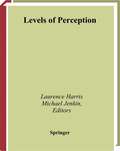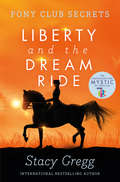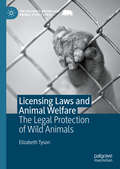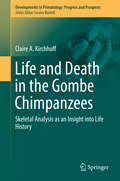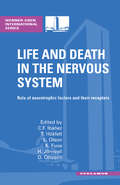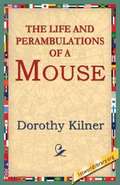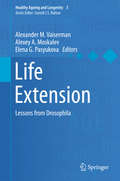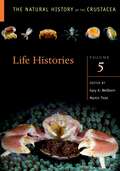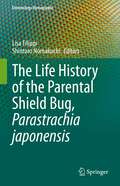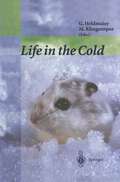- Table View
- List View
Leukocyte Recruitment, Endothelial Cell Adhesion Molecules, and Transcriptional Control: Insights for Drug Discovery
by Tucker CollinsThe localized attachment of circulating leukocytes to endothelium has been recognized as the cellular hallmark of the inflammatory response. This adhesive interaction, a necessary antecedent to the emigration of leukocytes from the blood into the tissues, is mediated by vascular adhesion molecules. Leukocyte Recruitment, Endothelial Cell Adhesion Molecules and Transcriptional Control: Insights for Drug Discovery outlines some of the cellular and molecular mechanisms of inflammation with contributions from top researchers. This volume provides an overview of three of these endothelial adhesion molecules, as examples of key mediators of leukocyte recruitment. It reviews the structure and regulation of these cell surface proteins and focus on the rapidly expanding field of transcriptional regulation of these inducible proteins, and closes with a discussion of drug discovery possibilities that target the regulation of leukocyte recruitment. This book will be of interest for any researchers, in academia or industry, looking for an overview of leukocyte recruitment or novel approaches to drug discovery.
Levels of Perception
by Laurence Harris Michael JenkinIn this book the authors relate and discuss the idea that perceptual processes can be considered at many levels. A phenomenon that appears at one level may not be the same as a superficially similar phenomenon that appears at a different level. For example "induced motion" can be analyzed in terms of eye movements or at the retinal level or at a much higher cognitive level: how do these analyses fit together? The concept of levels also makes us think of the flow of information between levels, which leads to a consideration of the roles of top-down and bottom-up (or feed-forward, feed-back) flow. There are sections devoted to vestibular processing, eye movement processing and processing during brightness perception. The final section covers levels of processing in spatial vision. All scientists and graduate students working in vision will be interested in this book as well as people involved in using visual processes in computer animations, display design or the sensory systems of machines.
The Liars of Nature and the Nature of Liars: Cheating and Deception in the Living World
by Lixing SunA natural history of cheating from selfish genes to lying politiciansNature is rife with cheating. Possums play possum, feigning death to cheat predators. Crows cry wolf to scare off rivals. Amphibians and reptiles are inveterate impostors. Even genes and cells cheat. The Liars of Nature and the Nature of Liars explores the evolution of cheating in the natural world, revealing how dishonesty has given rise to wondrous diversity.Blending cutting-edge science with a wealth of illuminating examples—from microscopic organisms to highly intelligent birds and mammals—Lixing Sun shows how cheating in nature relies on two basic rules. One is lying, by which cheaters exploit honest messages in communication signals and use them to serve their own interests. The other is deceiving, by which cheaters exploit the biases and loopholes in the sensory systems of other creatures. Sun demonstrates that cheating serves as a potent catalyst in the evolutionary arms race between the cheating and the cheated, resulting in a biological world teeming with complexity and beauty.Brimming with insight and humor, The Liars of Nature and the Nature of Liars also looks at the prevalence of cheating in human society, identifying the kinds of cheating that spur innovation and cultural vitality and laying down a blueprint for combatting malicious cheating such as fake news and disinformation.
Liberty and the Dream Ride: Christmas Special (Pony Club Secrets #11)
by Stacy GreggSaddle up for the eleventh Pony Club Secrets adventure! Issie leaps to new heights with showjumper Comet, but will she ride to victory on Liberty? The penultimate book in a best-selling pony adventure series.
Licensing Laws and Animal Welfare: The Legal Protection of Wild Animals (The Palgrave Macmillan Animal Ethics Series)
by Elizabeth TysonThis book considers the efficacy of the common regulatory model of the licensing regime as a means of regulating animal use in England, with a particular focus on wild animals and the regime’s ability to ensure animal welfare needs are met. Using information gleaned from over 550 inspection reports relating to the period 2008 through 2019, obtained using FOI Act requests, the book analyses the extent to which animals used by these industries are protected by law. Tyson analyses the limitations present in the practical application of English legislation responsible for creating a number of relevant licensing regimes.The regimes discussed include: The Zoo Licensing Act 1981, the now repealed Welfare of Wild Animals in Travelling Circuses Regulations 2012, and the Animal Welfare (Licensing of Activities Involving Animals) Regulations 2018, introduced under the Animal Welfare Act 2006.Exploring the weakness in the use of this type of regulatory model, Tyson proposes compelling recommendations for change in future policy development. Making an important contribution to the question of enforcement of animal welfare laws, this book provides useful and original insights into the implementation of licensing regimes, and will be of particular interest to scholars of animal welfare law, animal ethics, and critical animal studies.
Licht- und elektronenmikroskopische Untersuchungen am Subcommissuralorgan der Maus (Advances in Anatomy, Embryology and Cell Biology)
by Heike HerrlingerLife: The beautifully illustrated natural history book for kids
by Elli Woollard“While up in the air, warm and bright, Feathery creatures with wings took flight.Soaring high in the blissful breeze,And deep in the wind whipped waves of the seas.”From tiny dots of microscopic bacteria to enormous dinosaurs.Through the Ice Ages and the gallop of evolution.From cavemen to cars, discover how our world began.Elli Woollard's lyrical text is a pitch-perfect blend of storytelling, science and wonder. Life will fascinate and entertain the curious child, with Dorien Brouwers' immersive artwork heightening the beauty and inspiring awe in readers young and old.
Life and Death in the Gombe Chimpanzees: Skeletal Analysis as an Insight into Life History (Developments in Primatology: Progress and Prospects)
by Claire A. KirchhoffThis book addresses how skeletons can inform us about behavior by describing skeletal lesions in the Gombe chimpanzees, relating them to known life histories whenever possible, and analyzing demographic patterns in the sample. This is of particular interest to both primatologists and skeletal analysts who have benefited from published data on a smaller, earlier skeletal sample from Gombe. The Gombe skeletal collection is the largest collection of wild chimpanzees with known life histories in existence, and this work significantly expands the skeletal sample from this long-term research site (49 chimpanzees). The book explores topics of general interest to skeletal analysts such as demographic patterns, which injuries leave signs on the skeleton, and rates of healing, and discusses both qualitative and quantitative analysis of the patterning of lesions. The book presents the data in a narrative style similar to that employed in Dr. Goodall’s seminal work The Chimpanzees of Gombe. Readers already familiar with the Gombe chimpanzees are likely to appreciate summaries of life events correlated to observable skeletal features. The book is especially relevant at this time to remind primate conservationists of the importance of the isolated chimpanzee population at Gombe National Park as well as the availability of the skeletons for study, both within the park itself as well as at the University of Minnesota.
Life and Death in the Nervous System: Role of Neurotrophic Factors and Their Receptors
by C.F. IBÁÑEZ, T. HÖKFELT, L. OLSON, K. FUXE, H. JÖRNVALL, D. OTTOSONLife and Death in the Nervous System
Life and Otter Miracles: The perfect feel-good book from the #1 bestselling author of Away with the Penguins
by Hazel PriorFrom the bestselling author of Richard & Judy's pick Away with the Penguins comes this 'otterly' delightful, heart-warming and feel-good story about the healing power of nature.'A lovely holiday read . . . Packed full of humanity and otters!' Sally Page'This book was just amazing. It made me laugh and cry!' *****'There is so much to love and treasure in this story' *****'This book was a delight from start to finish!' *****'Glorious dose of otter cuteness' *****You loved Veronica McCreedy. Now meet Phoebe Featherstone . . ._____Down by the river, Phoebe Featherstone is about to make a life-changing discovery . . .Clever, nosy Phoebe is unable to get out much, but she has a talent for uncovering her neighbours' secrets by examining the parcels delivered by her courier father, Al.When they discover an abandoned baby otter on the riverbank, Phoebe must step out of her comfort zone - and she experiences an unexpected sense of happiness that she has not felt in a very long time. But now, further secrets are coming to light.Phoebe soon realizes that something is amiss at the local otter sanctuary. She will need to overcome her own closely guarded issues and put all her sleuthing skills to good use if she wants to save the otters . . . and in the process, change her life for ever._____Praise for Hazel Prior:'A lovely holiday read . . . Packed full of humanity and otters!' Sally Page'Beautifully written by a born storyteller' Lorraine Kelly'Uplifting, heartwarming and wonderful, an utterly charming story - I loved it!' Faith Hogan'This gorgeous book has everything!' Clare Pooley'Perfect fireside read' Trisha Ashley'A glorious, life-affirming story. I read it in a day' Clare Mackintosh'A story that readers will be sure to fall in love with. Otterly charming!' Freya Sampson'Funny, bittersweet and wholly original' Daily Express
The Life and Perambulations of a Mouse
by Dorothy KilnerDuring a remarkably severe winter, when a prodigious fall of snow confined everybody to their habitations, who were happy enough to have one to shelter them from the inclemency of the season, and were hot obliged by business to expose themselves to its rigour, I was on a visit to Meadow Hall; where had assembled likewise a large party of young folk, who all seemed, by their harmony and good humour, to strive who should the most contribute to render pleasant that confinement which we were all equally obliged to share. Nor were those further advanced in life less anxious to contribute to the general satisfaction and entertainment. After the more serious employment of reading each morning was concluded, we danced, we sung, we played at blind-man's-buff, battledore and shuttlecock, and many other games equally diverting and innocent; and when tired of them, drew our seats round the fire, while each one in turn told some merry story to divert the company.
Life at Interfaces and Under Extreme Conditions: Proceedings of the 33rd European Marine Biology Symposium, held at Wilhelmshaven, Germany, 7–11 September 1998 (Developments in Hydrobiology #151)
by IngridKröncke SabineDittmann GerdLiebezeitInterfaces between media, whether air-water or sediment-water interfaces or organisms themselves, pose considerable problems to marine organisms attempting to live at these boundaries. In the present volume, a number of authors address various aspects of these two topics. Locations under scrutiny range from intertidal areas to the deep sea, while both macro-and meiofaunal organisms are investigated. Distribution patterns and effects of variable temperatures, pressures, and salinities are analysed. Aspects of fouling induction and prevention are also addressed. This book is intended as a progress report from the 33rd European Marine Biology Symposium held in Wilhelmshaven, Germany, in September 1998.
The Life Cycle of the Corpus Luteum
by Rina MeidanThis book describes the life cycle of a unique endocrine gland that is absolutely essential for the establishment and maintenance of pregnancy in all mammalian species. The corpus luteum is unique because it is formed and destroyed every (non-fertile) reproductive cycle. When fertilization occurs, the corpus luteum is rescued or maintained. The processes that control corpus luteum formation, demise (luteolysis), or maintenance are just beginning to be unraveled in recent years; they involve diverse cell types and mechanisms. Some of these processes resemble tumor development—angiogenesis, for instance—but interestingly enough, this resemblance is only up to a point. The corpus luteum uses mechanisms that allow its normal, physiological growth and disappearance. Pulling together key research on the corpus luteum, this volume is of interest to both reproductive endocrinologists and comparative physiologists, with clinical relevance spanning comparative animal studies to women's health.
The Life Cycles of Butterflies: From Egg to Maturity, a Visual Guide to 23 Common Garden Butterflies
by Judy Burris Wayne RichardsThis stunning photographic guide will have butterfly enthusiasts of all ages aflutter. Judy Burris and Wayne Richards include more than 400 full-color, up-close images that present the life cycles of 23 common North American butterflies in amazing detail. Watch caterpillars hatch from eggs, eat and grow, form into chrysalides, emerge as colorful butterflies, and fly through the air. You&’ll also learn which plants butterflies avoid and which native species they&’re attracted to, so you can create your own backyard butterfly haven.
Life Extension: Lessons from Drosophila (Healthy Ageing and Longevity #3)
by Alexander M. Vaiserman Alexey A. Moskalev Elena G. PasyukovaThis book looks at aging through research on Drosophila, the fruit fly that is one of the most widely used model organisms in bio gerontology. Work in model organisms can expand the theoretical knowledge of aging: it yields valuable insight into the molecular and cellular processes that underlie aging process, and it can perhaps provide new therapeutic targets for the treatment of age-related disorders in humans.Drosophila models have been developed for a large variety of aging-related processes and diseases, and this book provides readers with an overview of current research on the use of the Drosophila model to understand the genetic, molecular and physiological mechanisms that underlie the aging process. Themes of health span, life extension and longevity-associated genes emerge in this collation of international research on Drosophila that is of relevance to geriatrics and gerontology, animal genetics and genomics, and biomedicine.This fascinating, illustrated book will be of interest to a wide audience, ranging from academic researchers to the general reader.
Life Histories: Volume 5 (The Natural History of the Crustacea)
Crustaceans are increasingly being used as model organisms in all fields of biology, including neurobiology, developmental biology, animal physiology, evolutionary ecology, biogeography, and resource management. Crustaceans have a very wide range of phenotypes and inhabit a diverse array of environments, ranging from the deep sea to high mountain lakes and even deserts. The evolution of their life histories has permitted crustaceans to successfully colonize this variety of habitats. Few other taxa exhibit such a variety of life histories and behavior. A comprehensive overview of their life histories is essential to the understanding of many aspects of their success in marine and terrestrial environments. This volume provides a general overview of crustacean life histories. Crustaceans have particular life history adaptations that have permitted them to conquer all environments on earth. Crustacean life cycles have evolved to maximize fecundity, growth, and ageing, in a wide range of environmental conditions. Individual contributions contrast benefits and costs of different life histories including sexual versus asexual production, semelparity versus iteroparity, and planktonic larvae versus direct development. Important aspects of particular behaviors are presented (e.g. migrations, defense and territorial behaviors, anti-predator behavior, symbiosis).
The Life History of the Parental Shield Bug, Parastrachia japonensis (Entomology Monographs)
by Lisa Filippi Shintaro NomakuchiThis book presents the discoveries made during nearly three decades of research on the parental shield bug, Parastrachia japonensis inhabiting Kyushu Island, Japan. P. japonensis has evolved a unique and fascinating life history, characterized by extreme behavioral and physiological adaptations that have culminated in a singularly dependent relationship with its lone host tree, Schoepfia jasminodora (Olacaceae), which is a generally scarce and unreliable resource. It is expected that the evolution of parental care behaviors in the strictly semelparous P. japonensis was more directly influenced by the benefit to females that arises from enhanced survivorship of current offspring, rather than any possible cost the females might incur in terms of reduced future reproductive success, because no future reproduction is possible. The authors explain how the different parental cares in this species enhance offspring survivorship in the context of the ecological conditions it has experienced over evolutionary time. The book begins with a recap of the earliest studies, the reports through 1991, and then introduces the many fascinating aspects of the life history, neurobiology, physiology and behavior of P. japonensis that have been newly discovered since, and those aspects that have been confirmed through experimentation over the past thirty years. This comprehensive review of information will be useful for comparative studies of parental care in other semelparous and iteroparous organisms experiencing both similar and different ecological constraints. The book will be of academic interest to undergraduate and graduate students of entomology, zoology, behavior, and behavioral ecology.
Life in a Shell: A Physiologist's View of a Turtle
by Donald C. JacksonTrundling along in essentially the same form for some 220 million years, turtles have seen dinosaurs come and go, mammals emerge, and humankind expand its dominion. Is it any wonder the persistent reptile bested the hare? In this engaging book physiologist Donald Jackson shares a lifetime of observation of this curious creature, allowing us a look under the shell of an animal at once so familiar and so strange. Here we discover how the turtle’s proverbial slowness helps it survive a long, cold winter under ice. How the shell not only serves as a protective home but also influences such essential functions as buoyancy control, breathing, and surviving remarkably long periods without oxygen, and how many other physiological features help define this unique animal. Jackson offers insight into what exactly it’s like to live inside a shell—to carry the heavy carapace on land and in water, to breathe without an expandable ribcage, to have sex with all that body armor intervening. Along the way we also learn something about the process of scientific discovery—how the answer to one question leads to new questions, how a chance observation can change the direction of study, and above all how new research always builds on the previous work of others. A clear and informative exposition of physiological concepts using the turtle as a model organism, the book is as interesting for what it tells us about scientific investigation as it is for its deep and detailed understanding of how the enduring turtle “works.”
Life in Colour: How Animals See the World
by Dr. Martin StevensBeauty is more than skin deep.'The natural world is awash with colour, but we are only seeing half the story. If we could see things as animals do, our world would become unimaginably brighter. Now, thanks to new science and technology, we can at last open our eyes.' - Sir David AttenboroughIn nature, colour is more than a source of beauty; it's a form of vital communication. Depending on the situation, colour says different things - it can be an expression of power or seduction, warning or deceit - and it can even, occasionally, save your life. Accompanying a major new BBC series with David Attenborough, Life in Colour explores the fascinating story of how colour works in the natural world. From the 'trichromatic' vision of Silver Leaf Langurs, which allows them to see orange and red against forest foliage - the colours not only of ripe fruit, but of their young - to African Mandrills who use their colouration to do battle, Professor Martin Stevens reveals a complex system of messaging visible only to those who know the code.Based on the latest scientific research in the field, and illustrated with stunning photography throughout, Life in Colour reveals a world previously unknown to us.
A Life in Nature: Or How to Catch a Mole
by Marc HamerA captivating, life-affirming memoir of a life in nature that celebrates finding wonder in our world. 'A wonderful book... It has taught me a lot. I feel great love for it' MAX PORTERAt the age of sixteen, Marc Hamer left home with only a rucksack and started walking. By day, he observed the animals and birds. By night, he slept under hedges, in woodlands and on riverbanks. It was the beginning of a life in nature.Years later, now working as a gardener and mole-catcher in the Welsh countryside, Marc tells of the experiences that have shaped him and of the wonders that he encounters each day. He considers, too, the fascinating ways of the mole and the myths that surround this curious creature.This beautiful, meditative book explores what nature can teach us about ourselves and our search for contentment. It is a celebration of living peacefully and finding joy in the world around us.'It is rare to encounter such respect and understanding of nature' Rosamund Young, author of The Secret Life of Cows** Longlisted for The Wainwright Prize 2019 **(Published in hardback as How to Catch a Mole)
A Life In Nature
by Sir Peter Scott'The Patron Saint of Conservation' Sir David Attenborough'Peter Scott was a huge influence on my childhood...Later on in life I had the good fortune both to meet and to interview him, and he remains, for me, a hero. His knowledge, his kindness to me and his generosity of spirit have remained an influence in my own sphere of natural history....To meet one's heroes can sometimes be a let-down. That was most certainly not the case with Peter Scott.' Alan TitchmarshA Life In Nature is a portrait of Peter Scott collected from his own conversations, articles and broadcasts including thoughts on expeditions to Lapland, Conservation and Africa, his travels in Europe and much more. Illustrated by Peter's own beautiful illustrations. Sir Peter Scott had a truly incredible life. He was the only son of legendary explorer Captain Scott. His godfather was JM Barrie and he was married to Elizabeth Jane Howard. He also represented Great Britain and Northern Ireland at sailing in the 1936 Berlin Olympic Games, winning a bronze medal. He founded the Wildfowl and Wetlands Trust and also helped to found the Worldwide Fund for Nature.This is a beautiful and timely re-discovered book, perfect for those who are interested in preserving our planet.
Life in the Cold: Eleventh International Hibernation Symposium
by Gerhard Heldmaier Martin F. Bach Susanne KlausThis book contains the proceedings of the 11 'h international symposium dedicated to the understanding of animal "Life in the Cold", held at Jungholz (Austria), August 13-18, 2000. In 55 chapters contributed by researchers from 16 countries the current state of knowledge is reviewed, and the most recent developments and discussions in this field are highlighted. The first symposium on hibernation and life in the cold was held in 1959, and from then on they continued to occur every 3-5 years. The regular occurrence of these meetings became almost a tradition. A tradition which is entirely based on the enthusiasm of participants, and was nourished by scientific progress in this area during the past decades. The first symposium in 1959 was organised by Charles P. Lyman and Albert R. Dawe and was almost entirely dedicated to hibernation and torpor. This has been a backbone topic of the following symposia, although other aspects of animal energetics, thermal physiology and biochemistry were included in later meetings.
Life in the Dark: Illuminating Biodiversity in the Shadowy Haunts of Planet Earth
by Dant © FenolioDeep inside caves, at the bottoms of oceans and lakes, beneath the ground: these concealed habitats are absent of sunlight. This strange and fascinating world of complete darkness is not a solitary place;¢;‚¬;€?it is inhabited by millions of life forms. Yet most humans;¢;‚¬;€?creatures of daylight;¢;‚¬;€?have never seen any of them. Until now. In this fascinating;¢;‚¬;€?sometimes eerie;¢;‚¬;€?book, extreme wildlife photographer and scientist Dant;© Fenolio brings the denizens of these shadowy haunts into focus. Life in the Dark shows us the many ways in which life forms have adapted to lightless environments, including refinements of senses, evolution of unique body parts, and illumination using "biological flashlights." With more than 200 mesmerizing color photographs, Life in the Dark unveils bizarre creatures like the firefly squid, the giant Amazonian catfish, the Chinese cavefish, and even the human bot fly, which lives in the darkness beneath its host;€™s skin. Fenolio;€™s rich and vibrant images shed new light on the world;€™s fascinating creatures of darkness.
Life in the Dark: Illuminating Biodiversity in the Shadowy Haunts of Planet Earth
by Dant © FenolioDeep inside caves, at the bottoms of oceans and lakes, beneath the ground: these concealed habitats are absent of sunlight. This strange and fascinating world of complete darkness is not a solitary place;¢;‚¬;€?it is inhabited by millions of life forms. Yet most humans;¢;‚¬;€?creatures of daylight;¢;‚¬;€?have never seen any of them. Until now. In this fascinating;¢;‚¬;€?sometimes eerie;¢;‚¬;€?book, extreme wildlife photographer and scientist Dant;© Fenolio brings the denizens of these shadowy haunts into focus. Life in the Dark shows us the many ways in which life forms have adapted to lightless environments, including refinements of senses, evolution of unique body parts, and illumination using "biological flashlights." With more than 200 mesmerizing color photographs, Life in the Dark unveils bizarre creatures like the firefly squid, the giant Amazonian catfish, the Chinese cavefish, and even the human bot fly, which lives in the darkness beneath its host;€™s skin. Fenolio;€™s rich and vibrant images shed new light on the world;€™s fascinating creatures of darkness.
Life in the Open Ocean: The Biology of Pelagic Species
by Joseph J. Torres Thomas G. BaileyLife in the Open Ocean Life in the Open Ocean: The Biology of Pelagic Species provides in-depth coverage of the different marine animal groups that form the communities inhabiting the ocean’s pelagic realm. This comprehensive resource explores the physical environment, foraging strategies, energetics, locomotion, sensory mechanisms, global and vertical distributions, special adaptations, and other characteristics of a wide array of marine taxa. Bringing together the most recent information available in a single volume, authors Joseph J. Torres and Thomas G. Bailey cover the Cnidaria (stinging jellies), the ctenophores (comb jellies), pelagic nemerteans, pelagic annelids, crustaceans, cephalopods and pelagic gastropods, invertebrate chordates, as well as micronektonic and larger fishes such as sharks, tunas, mackerels, and mahi-mahi. Detailed chapters on each pelagic group describe internal and external anatomy, classification and history, feeding and digestion, bioluminescent systems and their function, reproduction and development, respiration, excretion, nervous systems, and more. The first book of its kind to address all of the major animal groups comprising both the swimmers and drifters of the open sea, this important resource: Explains how different animals have adapted to live in the open-ocean environment Covers all sensory mechanisms of animals living in the pelagic habitat, including photoreception, mechanoreception, and chemoreception Treats the diverse micronekton assemblage as a community Includes a thorough introduction to the physical oceanography and properties of water in the pelagic realm Life in the Open Ocean: The Biology of Pelagic Species is an excellent senior-level undergraduate and graduate textbook for courses in biology and biological oceanography, and a valuable reference for all those with interest in open-ocean biology.

